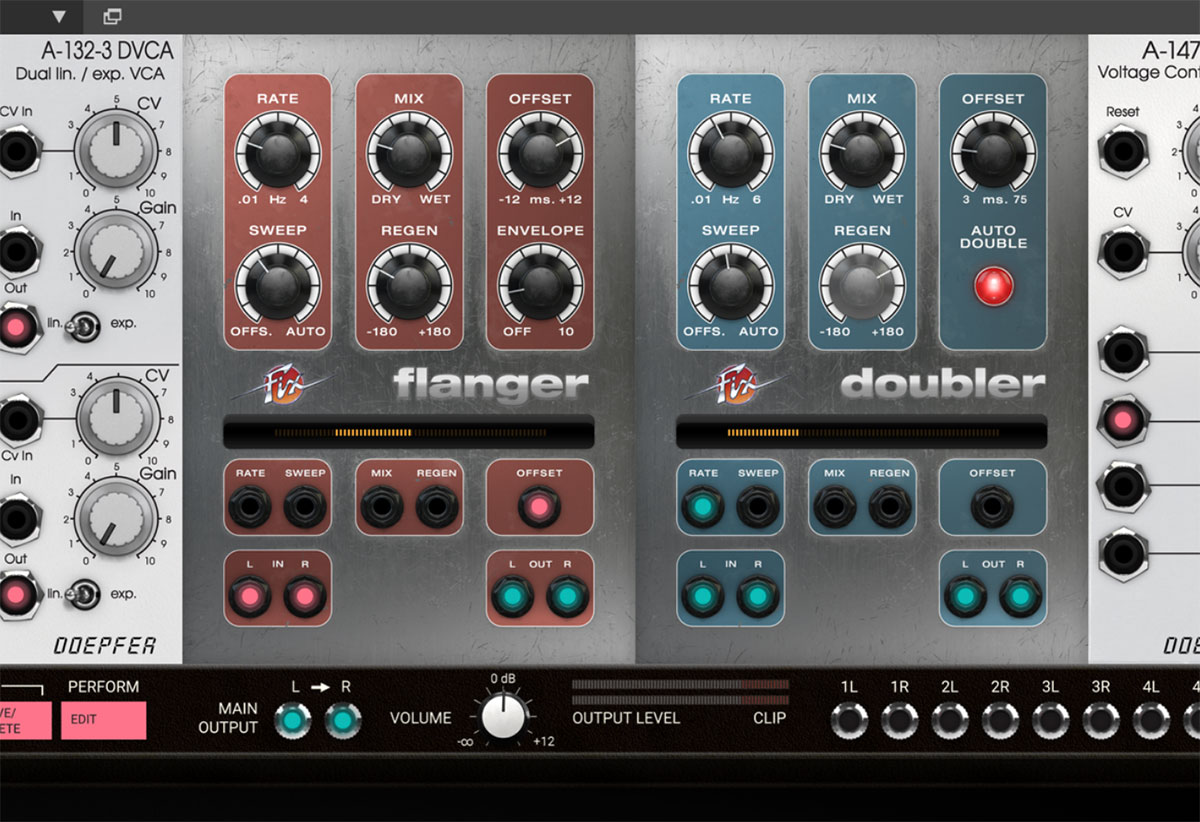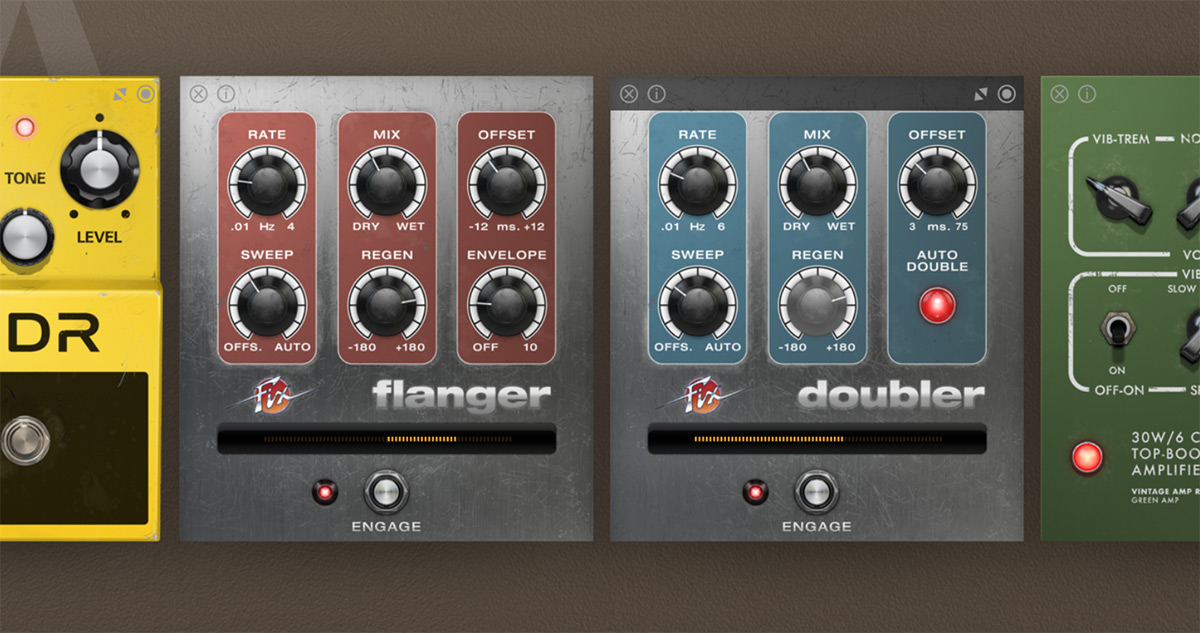User Manual
Fix Doubler
Intro
User Interface
Tweaking Tips
Fix Flanger and Doubler for Modular and Amp Room
Extended Features
Credits
Double tracking or overdubbing of tracks and instruments is a studio practice that goes back to the early roots of recording. Although pioneers like Les Paul experimented with overdubbing on recordings during the 1930s and 1940s, this method wasn’t adopted as a studio practice until the arrival of the multi-channel tape recording machines. While overdubbing became a studio standard, especially on lead vocals, time constraints and demands from musicians led to the next innovation in dubbing: Auto Doubling.
While some engineers already had experimented with short slap-back echo to achieve a similar effect, this technique was further developed in the 1960s with the “Artificial Double-Tracking” of Abbey Road Studios. With the rise of digital signal processing in the 1970s, these techniques were further developed and gave birth to the first digital harmonizers and doublers. Dedicated digital units were also developed by this time, but were strictly limited to studio works due to their size. Later, the Flanger effect, a side-effect of auto doubling, was popularized as an effect for guitar and drums.
This plug-in is based on the Real Time Auto Doubler AD-2 by Paul Wolff. It was a unique hardware designed to do classic tape-style doubling, and quickly became loved by musicians and sound engineers, but unfortunately never made it into serial production. The Fix Doubler is what the AD-2 was, and more. Paul Wolff has expanded the original concept and introduced several new techniques in order to give you a auto doubler that combines a classic sound with the versatility of the digital world.The Fix Doubler delivers texture and extraordinary richness on vocals and polyphonic instruments.
The Fix Doubler panel contains the following ten controls.
Mix: Sets the balance between the doubled and the direct signal. Set it to INPUT to only get the input sound, or fully to DELAY to only hear the delayed signal. Set it somewhere in the middle (30-70%) to get a nice doubling effect.
Engage: Use Engage as a smooth bypass if you want to turn on or off the effect during a song.
Stereo: Turn on to widen the stereo image, or turn a mono signal into a stereo signal. Make sure to insert the plug-in as a STEREO or a MONO-TO-STEREO plug-in for the widening effect to work.
Dual Sweep can also be used to widen the stereo image or turn a mono signal into stereo
Regen: Sets the amount of delay feedback. Turning Regen up makes the effect sound fuller, but too much Regen will make it sound flangy and hollow. This control is not active (greyed out) when Auto Double is in use.
Auto Double: Turns on and off the AUTO DOUBLE mode. The Auto Double mode will put the secret sauce in the stew and make everything sound great!
Delay Offset: Sets the delay offset of the doubled signal. Longer delay times will yield a more slap back kind of doubling while shorter delay times will sound more flanger-like.
Sweep: Sets the balance between the fixed Delay Offset and the sweep. Turning this knob clockwise will cause the sweep to affect the doubled signal more.
Rate: Sets the speed of the sweep, ranging from 0.01 milliseconds to 6 milliseconds. The sweep amount is also reversely affected by sweep rate (see below), so that faster rates makes the sweep less apparent. This is by design to ensure a more natural doubling sound and a constant pitch change in the delayed signal.
Dual Sweep: Turn this on to get two independent doublers out of phase with each other for the LEFT and RIGHT channel. This can make the doubling effect sound fuller, and also create a nice stereo effect for mono tracks.
Sweep Type: Selects the type of waveform used for the sweep: TRIANGLE, SINE and RANDOM.
TRIANGLE: Constant pitch during the sweep, suitable for low Sweep settings and Dual Sweep.
SINE: Pitch is changing throughout the whole sweep, nice on monophonic instruments and higher Sweep settings.
RANDOM: The pitch shift is random, and will sound more natural when used sparingly. Low Sweep and Rate is preferred for this one.

-
Engage
-
Stereo
-
Auto double
-
Dual sweep
-
Delay meter
-
Waveform type Triangle, Sine, Random
-
Mix
-
Regen
-
Delay offset
-
Sweep
-
Rate
Here are a few pointers to guide you when using the Fix Doubler:
Delay Offset
Using 20 to 45 milliseconds of delay and subtly mixing the delayed signal with the original tends to “fatten up” the sound, especially when using the STEREO or DUAL SWEEP modes.This creates an illusion of more than one singer or player and is also an excellent method of adding lushness to string or horn sections. Instruments with sharp transients, such as rhythm guitars or drums, will typically require a shorter delay, vocals medium delays, and strings and horns slightly longer delay times.
Mix
Mix ratio is essential to the perceived “fatness” of the resulting signal. A completely wet signal (Mix fully clock-wise) can be OK when using more extreme settings in order to create vibrato effects, but normally a mix between 20% and 50% is recommended to create a subtle, natural sounding vocal doubling or chorus.
Sweep
The Sweep is the key ingredient when creating a subtle or fat doubling chorus. Too much Sweep, and it will sound pitchy and wobbly, too little and you’ll just get a slap back echo effect.
Chorus Effect
A natural sounding chorus effect is easily obtained by using the auto double function while setting the delay offset at a low setting (around 20–30 milliseconds), Rate at around 3–4 Hz and Sweep almost all the way to OFFSET.
Tape Wow and Flutter
By using a short Delay Offset at around 7 ms, Sweep set to 2–3%, RANDOM waveform with slow Rate, and Mix fully clockwise, you will get a tape machine like wow and flutter effect.
Vibrato
A vibrato effect can be achieved by using a completely wet signal, a fast sweep (Rate at 5–6 Hz), Sweep at 5–10%, and SINE or TRIANGLE waveforms. Use Delay Offset and Regen to get different characters of vibrato.

Original Auto Doubler hardware, the Real Time Auto Doubler AD-2 from 1979.
Fix Flanger and Doubler for Modular and Amp Room
Fix Flanger and Doubler can also be used as two separate modules in Modular and as two separate effects in Amp Room.
The algorithms are the same, but the interfaces are focused on the most relevant features for an easy and quick access.
The use in Modular allows for automatic voltage control of some of the parameters.

Fix Flanger and Doubler for Modular

Fix Flanger and Doubler for Amp Room
Here a brief description of the features of these modules and effects:
Fix Doubler
Parameters
Rate: Sets the speed of the sweep, ranging from 0.01 Hz to 6 Hz.
Sweep: Sets the balance between the fixed Delay Offset and the auto sweep.
Mix: Sets the balance between dry and wet signal.
Regen: Sets the amount of delay feedback.
Offset: Sets the delay offset of the doubled signal.
Auto Double: Turns on and off the AUTO DOUBLE mode.
In addition, the module has:
Inputs
Left input: Input for left channel.
Right input: Input for right channel.
Rate: CV Input for the Rate parameter.
Sweep: CV Input for the Sweep parameter.
Mix: CV Input for the Mix parameter.
Regen: CV Input for Regen parameter.
Offset: CV Input for Delay Offset parameter.
Outputs
Left output: Output for left channel.
Right output: Output for right channel.
A whole range of added control can be accessed with Extended Features. Please see the separate "Extended Features" manual for more information.
Paul Wolff – Idea and original reference
Arvid Rosén – Model analysis and implementation
Niklas Odelholm– Programming and GUI
Kristofer Ulfves – User manual and initial testing
Paul Shyrinskykh – Quality assurance
Ulf Ekelöf – 3D rendering and graphics